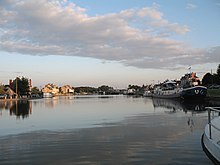Canal latéral à la Loire
| Canal latéral à la Loire | |
|---|---|
| Water code | FR : K --- 0072 |
| location | France , regions Bourgogne-Franche-Comte , Auvergne-Rhône-Alpes and Center-Val de Loire |
| length | 196 km |
| Built | 1822-1838 |
| class | I ( Freycinet class ) |
| Beginning | Crossing from the Canal du Center at Digoin |
| The End | It flows into the Canal de Briare at Briare |
| Descent structures | 37 |
| Ports | Digoin , Dompierre-sur-Besbre , Decize , Nevers , Briare |
| Junctions, crossings | Canal de Roanne à Digoin , Canal du Nivernais , formerly: Canal de Berry (NE section) |
| Used river | Loire |
| Outstanding structures | Briare Canal Bridge |
| Kilometrage | in the direction of flow of the Loire |
| Downhill | in the direction of flow of the Loire |
| Briare canal bridge over the Loire | |

The Canal latéral à la Loire (German: Loire-Seitenkanal ) is a shipping canal that runs in the French regions of Bourgogne-Franche-Comté , Auvergne-Rhône-Alpes and Center-Val de Loire . Together with the Canal du Loing , Canal de Briare and Canal du Center, it forms a chain of canals ( Route Bourbonnais ) that enables barges and pleasure craft to pass from the Seine to the Saône and on to the Mediterranean . Due to its construction, the seasonally unsafe use of the Loire River, which runs parallel to it, was initially reduced and finally completely dispensable for shipping .
Course and technical infrastructure
The canal begins in Digoin , where it connects to the Canal du Center . Then he crosses the Loire with the help of a canal bridge , where shortly afterwards the Canal de Roanne à Digoin joins from the left. It generally runs in a north-westerly direction and always keeps changing distance from the left bank of the Loire. Not until Briare does it cross the Loire again and a few kilometers later it flows into the Canal de Briare . Its total length is 196 kilometers.
It is a canal of the side canal type , which follows the course of the Loire without its own apex. The height difference of 98 meters is overcome with 37 locks . The locks are designed for ships of the standard size Freycinet . Several canal bridges were built to cross the Loire tributaries, the most famous being those of Digoin (across the Loire), Le Guétin (across the Allier ) and Briare (across the Loire).
Several branch channels connect the canal with important places or the river, where the ships can cross over to the Loire when the water level is suitable:
- Branch canal to Dompierre-sur-Besbre
- Branch canal to Decize (after crossing the Loire: connection to the Canal du Nivernais )
- Branch canal to Nevers
- Branch canal according to Givry- Fourchambault
- Branch canal to Saint-Thibault (municipality of Saint-Satur )
- Branch canal to Châtillon -Mantelots
Coordinates
- Starting point of the canal: 46 ° 28 ′ 47 " N , 3 ° 58 ′ 56" E
- End point of the canal: 47 ° 38 ′ 50 ″ N , 2 ° 45 ′ 30 ″ E
Crossed departments
- in the Bourgogne-Franche-Comté region: Saône-et-Loire and Nièvre
- in the Auvergne-Rhône-Alpes region: Allier
- in the Center-Val de Loire region: Cher and Loiret
Places on the canal

- Digoin
- Dompierre-sur-Besbre (via branch canal)
- Decize (via branch channel)
- Nevers (via branch canal)
- Marseilles-lès-Aubigny
- Sancerre
- Saint-Satur
- Châtillon-sur-Loire
- Briare
history
The canal was built between 1822 and 1838. It ran from Briare to Chatillon-sur-Loire on the right of the Loire. However, it had difficult river passages, including a. at Châtillon-sur-Loire, where the crossing between the locks at Écluse No. 41 of the Mantelot and Écluse No. 42 des Combles took place. For this crossing, a crossing channel was created in the river with elaborate engineering structures. Due to the river crossings, shipping remained dependent and dangerous on the changing water flow of the Loire even after the later use of steam-powered cable winches. To solve this problem, Léonce-Abel Mazoyer built the canal bridges from 1890 to 1896 , and the canal on the left of the Loire to Chatillon-sur-Loire was built and at the same time rebuilt to the Freycinet standard. The operation of lock 41 ended in 1950.
Attractions

The Briare Canal Bridge is a trough bridge with a length of 662.69 m and a width of 11.50 m (including the towpaths ). It was built between 1890 and 1896 as a riveted iron structure. It can accommodate ships with a draft of up to 2.2 m. For larger ships up to the Freycinet standard, passage is only possible without oncoming traffic.
The bridge was designed by chief engineer Léonce-Abel Mazoyer and the pilasters were designed by engineer Charles Sigault . During the construction work, Daydé & Pillé were responsible for the metal bridge panels, and Eiffel et Cie. involved in substructure and foundations. Therefore, the architecture of the bridge is often wrongly attributed to Gustave Eiffel . After its construction, the trough bridge was the largest in Europe for a whole century, until this position was taken over by the Magdeburg canal bridge .
Web links
literature
- Voies Navigables, Canaux du Center , 1998, Editions Grafocarte publishing house ISBN 2-7416-0058-9
Individual evidence
- ↑ a b The information on the length of the canal is based on the information on the Canal latéral à la Loire from SANDRE (French), accessed on February 21, 2020, rounded to full kilometers.

